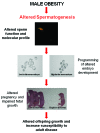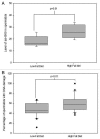Impact of obesity on male fertility, sperm function and molecular composition
- PMID: 23248766
- PMCID: PMC3521747
- DOI: 10.4161/spmg.21362
Impact of obesity on male fertility, sperm function and molecular composition
Abstract
Male obesity in reproductive-age men has nearly tripled in the past 30 y and coincides with an increase in male infertility worldwide. There is now emerging evidence that male obesity impacts negatively on male reproductive potential not only reducing sperm quality, but in particular altering the physical and molecular structure of germ cells in the testes and ultimately mature sperm. Recent data has shown that male obesity also impairs offspring metabolic and reproductive health suggesting that paternal health cues are transmitted to the next generation with the mediator mostly likely occurring via the sperm. Interestingly the molecular profile of germ cells in the testes and sperm from obese males is altered with changes to epigenetic modifiers. The increasing prevalence of male obesity calls for better public health awareness at the time of conception, with a better understanding of the molecular mechanism involved during spermatogenesis required along with the potential of interventions in reversing these deleterious effects. This review will focus on how male obesity affects fertility and sperm quality with a focus on proposed mechanisms and the potential reversibility of these adverse effects.
Figures



References
-
- Begg SVT, Barker B, Stevenson C, Stanley L, Lopez AD. The burden of disease and injury in Australia 2003. Canberra: AIHW, 2007:337.
-
- Aitken RJ, Allman-Farinelli MA, King LA, Bauman AE. Current and future costs of cancer, heart disease and stroke attributable to obesity in Australia - a comparison of two birth cohorts. Asia Pac J Clin Nutr. 2009;18:63–70. - PubMed
-
- Dixon T, Waters AM. A growing problem. Trends and patterns in overweight and obesity among adults in Australia 1980 to 2001. 2003:AIHW bulletin no. 8, AUS 36; 19pp.
-
- Sunderam S, Chang J, Flowers L, Kulkarni A, Sentelle G, Jeng G, et al. Centers for Disease Control and Prevention (CDC) Assisted reproductive technology surveillance--United States, 2006. MMWR Surveill Summ. 2009;58:1–25. - PubMed
LinkOut - more resources
Full Text Sources
Miscellaneous
